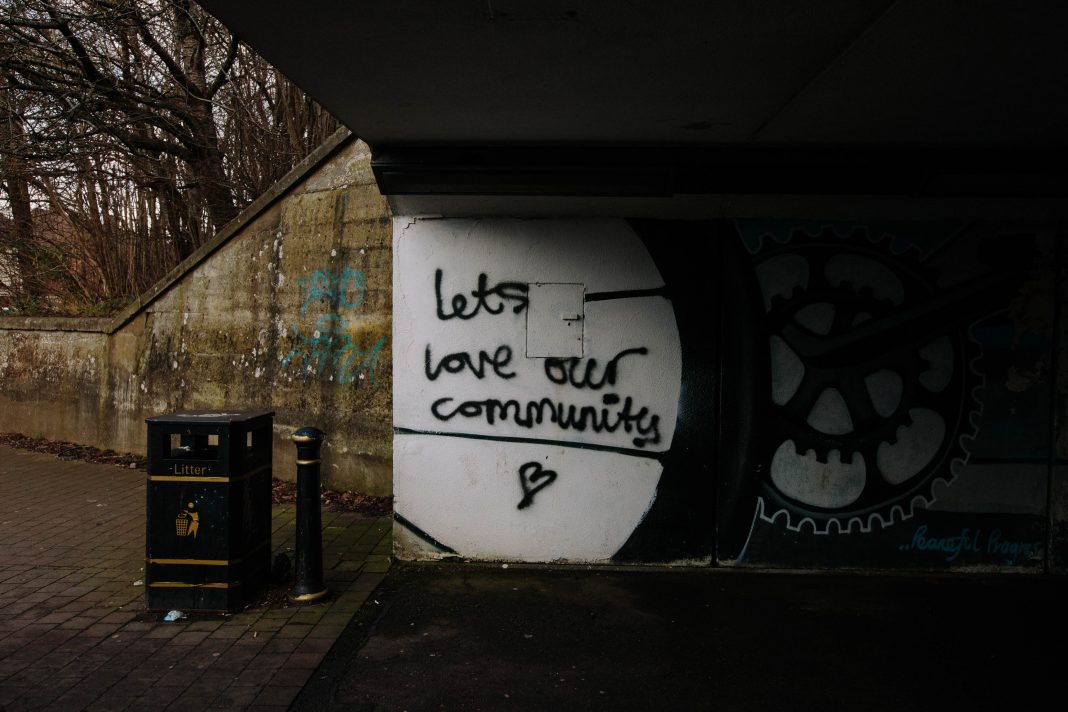Cities are still failing to cater for pedestrians and we’re struggling to get communities walking as a result. When it comes to implementing change, stakeholder backing greases the wheels and a coordinated bunch of folks can be an unstoppable force. But how can we harness this potential? In this article, we explain how to motivate people to take an active role in fostering walkability.
Humans are creatures of habit. Familiarity feels safe. But bad habits can be detrimental, and better ones can be difficult to establish – especially if they involve hard work, expense, or conflict.
While no two communities are the same, we’ve put together some pointers that will help rally walkers, whether you’re looking to implement infrastructure improvements or just get people moving.
Just What Is a Community?
Oxford University Press defines community as:
“A group of people living in the same place or having a particular characteristic in common.”
Alternatives chime with words such as “shared values”, “identity”, “common interests”, and “social group”. It’s about more than simple geography. Those in a community are bound together by joint experiences (or a lack thereof). The key is uniting them. But, for what reason?
Define the Problem
Get everyone walking. It’s a noble enough cause. But without direction, it seems a massive undertaking.
America Walks‘ tip for getting started: ask why people aren’t walking. This will root out the underlying issue(s) and focus your plan of action.
For example, parents may drive to kindergarten because pathways are unconnected or difficult to navigate with pushchairs, due to being too narrow, potholed, lacking in drop curbs, or completely absent. Wheelchair users sympathise.
Asking questions draws attention to specific issues and gets people hungry for a solution.
Power to the People
There is strength in union. Communicate your intentions clear and wide to bring people together to push for change.
Choose Your Battle Cry
Glossy publications (pamphlets, brochures, posters) don’t appeal to everyone – mainly affluent, white women. Community assets are proven game-changers: collaborate with churches, medical centres, non-health professionals, and local charities. These are trusted pillars of the community and when they espouse the benefits of walking and walkable streets, people listen. Their peers, in turn, will listen to them. These advocates, or Walkability Champions, are a perfect ally.
Take Your Message to the People
Innovate: drop an Instagram ad (this can be set up to reach people within a specific location) and pepper QR codes around the area you want to improve.
Shout aloud in the paper: whether it’s highlighting the problem, holding elected officials to account for lack of action, or celebrating success, the local press will lap it up. Column inches will reach out wide.
Enlist Micro-Level Decision-Makers
No one knows the needs of a community better than those who live in it. While it’s a coup to have politicians championing your cause (as if by magic, here we tell you how), grassroots concepts are most likely to flourish.
Warren Logan, Policy Director of Mobility and Interagency Relations in Oakland, California told us: “You have to create an environment that encourages people to […] actively participate in the engagement process”. Provide the opportunity and means for people to have a say in what happens in their city. This way, they will be aware of how they benefit personally and more open to accepting change – that perennial fear factor.
Guarantee Inclusivity
Include the whole community in the process.
Ensuring diverse populations – especially those traditionally not given a voice – are engaged, informed, represented, heard, and included in decision-making is fundamental to changing both human behaviour and urban landscapes.
Warren points out that this goes beyond making minorities visible on city councils: use culture-appropriate images, language, and symbols on literature and signage to make measures relatable. This generates trust and draws the full spectrum of society towards their walking opportunities.
Take heed! Moves that engage all people equally work best. Those that target specific socio-economic groups stand a risk of entrenching inequities and therefore alienation.
Cater for Your Audience
Respectful Design
Anna Zivarts from Disability Rights Washington identifies that 15-minute cities are often designed with able-bodied walking residents as a benchmark. A greengrocer just a quarter of an hour away for an active 20-something may be a 45-minute painful trek for their arthritic grandparents.
Safe cities where everything is within reasonable reach is the basis for getting people moving. Founder of Walk21 Jim Walker told us it is a matter of demonstrating “respect in the way that cities are designed and managed” for pedestrians. “That’s just a basic kindness.”
Build it and they will come… on foot.

Make Walking Unavoidable
Build walking into the fabric of everyday life.
Community-driven initiative Beelines in Manchester, UK, use bollards and planters to create filtered neighbourhoods, blocking vehicles from using side streets to avoid congested major routes. Now pedestrians and cyclists are the only through-flowing traffic.
Chris Boardman, the region’s walking and cycling commissioner is “absolutely unapologetic” about inconveniencing cars. And with good reason. Uptake in active transport increases when schools, services, and workplaces are accessible easily – or solely – by foot. The retail community, which initially condemns the loss of traffic, soon comes round – as shown in our case for walkable cities, pedestrians spend more.
Don’t just aim to involve your community in walkability, make walkability unavoidable within your community.
Give It a Go!
Trial something. Small-scale solutions are easier to set up and cheaper to implement. It also means you’re more likely to get permission and financial support from the City.
Examples:
- Repair a stretch of pavement on one side of the road and monitor the increase in daily walkers or reduction in traffic flow, speed, and accidents.
- Choose a patch in the neighbourhood for some new benches, and survey how custom increases for local retailers.
This gives people a chance to see your walkability plan in action, to test if it creates havoc or tranquillity. People are happy to make their opinions know. If they don’t start walking, try something else. If it works, you’ve got the attention and support of the community, and fuel for upscaling and permanency.
Celebrate the Public Space
People like to feel safe, heard, and included. People also like to have fun. Use it as a tool.
Sticky streets recognise that walkability isn’t just about getting from A to B. Pedestrian areas in your city are suited to socialising, lingering, hanging out. It gives people somewhere to be and a sense of appreciation.
Think of your own city. Is there a pedestrianised area – possibly a central square, directly outside city hall? What happens there? Our guesses include farmers’ markets, festivals, public events, protests, parades, speeches, concerts, impromptu am-dram performances, busking, and wedding photoshoots. Maybe there’s a café with outside tables, a (drinking) fountain, a parklet, or an art display. Maybe it’s home to a Christmas tree each December. None of this would be possible if this was open to traffic. Whoever could prefer the latter option?
So, when people aren’t convinced by how walking gives us healthier, longer lives, appeal instead to their hedonistic nature.
Community Buy-In in a Nutshell
Every community is a unique patchwork of geographies and stakeholders, each with its own situations, demographics, and needs. But they all stand to gain from a walkable neighbourhood.
Your community is united by a common problem, they just may not be aware of it. Frequent communication, a clear end goal, and ensuring everyone who stands to benefit is involved in the process are the building blocks for cohesion. Tangible rewards built around well-designed solutions that make walking inescapable provide motivation and, ultimately, a great deal of satisfaction.


